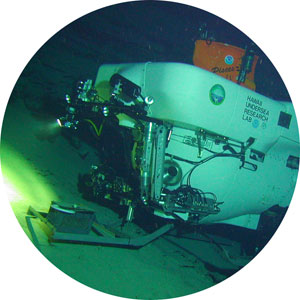Pisces IV Deep Diving Manned Submersible

GENERAL DATA
- Length: 20'
- Width: 10' 6"
- Height: 11'
- Weight: 13 tons
- Payload: 250 lbs.
- Crew: 1 Pilot 2 Observers
- Life Support: 140 hours for 3 people
- Max. Operating Depth: 6,500 ft.
(~2000 m)
- Power: 2 lead-acid battery systems:
- 120 VDC at 330 Ah capacity
- 12-24 VDC at 220 Ah cap.
- Propulsion : 2 side mounted
reversible thrusters tiltable through 100 degrees
- Speed: 3 Kts.
- Duration: 7-9 hours
CONSTRUCTION
- Builder: International Hydrodynamics
of Vancouver, British Columbia
- Classed by American Bureau of
Shipping
- Materials: Personnel sphere, Trim
spheres: HY 100 steel
- Frame: Welded, oil-filled, pressure
compensated 4130 tubular steel.
- Viewports: 3 forward looking acrylic
windows, 6" dia interior-14" dia exterior
- Penetrators: (28) 316 SS inserts to
pass electrical, hydraulic, air and oxygen supplies
through the hull.
LIFE SUPPORT
- Oxygen and CO2 absorbent
for daily use is sufficient for twice normal mission
duration.
- Independent emergency supplies
available for 120 hours for 3 people.
- Full face air masks available in case
of cabin air contamination.
- MSHA-NIOSH approved self-contained
Oxygen-Generating Breathing Apparatus available for 3
crew.
SYSTEMS
Buoyancy Control
- Soft ballast tanks displace a total
of 1904 lbs. Using H.P. air.
- Droppable descent/ascent weights.
- Hard ballast tanks and hydraulically
powered seawater pump give 450 lbs. of trim
adjustment.
H.P. Air
- Carried in 5 externally mounted
cylinders with a total capacity of 600 scf at 3000
psi. Used for ballast system and emergency breathing
apparatus.
Oxygen
- Two 22 ft3 cylinders
available for daily use. Independent emergency supply
in 4 externally mounted cylinders has a capacity of
480 cu. ft. at 3000 psi.
Ventilation
- Cabin Atmosphere is monitored by
oxygen analyzers. Oxygen level is maintained by
constant flow. CO2 is removed by a
electrically powered scrubber unit and granular CO2
absorbent material.
Hydraulic System
- Electric pump and solenoids provide 3
gallons per minute at 3000 psi to the following
equipment:
- HYCO manipulator
- Basket basket up and down
- Ascent/Descent weight drop
cylinders
- Thruster tilt
- Movable drop weights
- 2 camera pan and tilt system
- Tiltable scanning sonar head
- 2 spare functions for science
equipment
- A separate dedicated hydraulic
system operates a Schilling Orion manipulator.
Controls and Instrumentation
- The pilot has available all controls
necessary for the operation of all submersible systems
in both normal and emergency situations including
thruster controls, buoyancy controls and indicators,
battery condition instruments, depth and pressure
gauges, magnetic compass, life support monitoring
instruments and controls, and surface and underwater
communications.
EQUIPMENT
The submersible is equipped with the following items
and can be configured as necessary to accommodate a
variety of mission requirements.
- Insite Pacific MINI-ZEUS HDTV camera
- ROS low-light CCD color camera
- B&W low-light wide-angle CCD
- Digital video recorders
- Two hydraulically operated
manipulators
- General purpose science basket
- Applied Microsystems electronic CTD
profiler
- Tritech SeaKing digital HD sonar
- Kongsberg-Simrad 1007 200 m altimeter
- Benthos multi-frequency pinger
receiver
- TrackLink 5000HA USBL submersible
tracking system
- Sonatech long baseline acoustic
tracking system
- External lights: 3-250 W, 2-500 W
tungsten 2-400 W HMI's available
- 2 KVH digital magnetic compasses
- Externally mounted temperature probes
with internally mounted monitors
- Suction sampler 8-bottle Rosette
- Hydraulic cutters
- Hydraulic rotary saw
- Laser scaling system
- Push core samplers
- Sealable sediment scoops - 4 arrays
of 9 samplers, capacity ~1kg ea
- Water samplers - 2 arrays of 6
samplers, capacity ~700ml ea
SAFETY FEATURES
- Jettison equipment:
- Main trim weight 500 lb
- Port emergency drop weight 250 lb
- Starboard emergency drop weight 250
lb
- Thrusters can be jettisoned in the
event of entanglement
- Extended life support capacity for 3
to 5 days, mainly dependent on crew weight
- Salt water leak detectors in bilge,
battery boxes, electrical junction boxes, and
controllers
- Acoustic locating pinger receiver
system
- Emergency self contained re-breathers
- Full face mask air breathing system
for contaminated atmosphere
- Emergency life support rations,
water, and space blankets
- One main and one backup 24 VDC
emergency battery power banks to power:
- CO2 scrubber
- circulating fan
- cabin lights
- underwater telephone
- VHF radio
- tracking transponder
- hydraulic solenoids
- Soft ballast tanks have an
accessible exterior port to allow a rescue vehicle
to insert an external air source to add buoyancy.
[ Top of page ]
|

